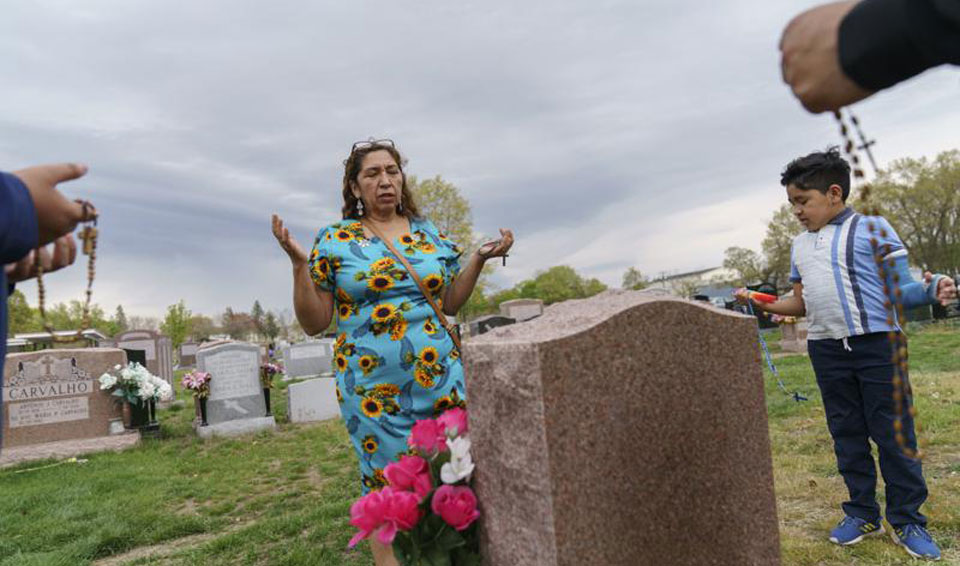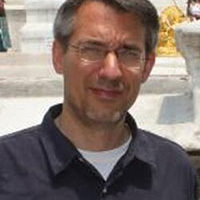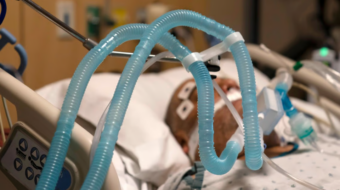
CENTRAL FALLS, R.I. (AP) — The beleaguered people of Central Falls moved quickly through the high school gym’s injection stations and then to rest on dozens of metal folding chairs, borrowed from the Knights of Columbus.
Immunity was at hand, but no one was celebrating.
Central Falls — the poorest and smallest city in the nation’s smallest state — is also among the hardest hit by COVID-19. Sorrow reaches across the city: The dead husband. The mother who came from Guatemala in search of a better life, only to die in a new land. The Polish priest who buried parishioner after parishioner.
The city has endured repeated waves of illness, with rates of confirmed cases that often dwarfed cities across New England.
But the troubles of Central Falls extend far back, long before the coronavirus arrived: Moonshine in the 1920s, cocaine in the 1980s. Illegal gambling dens in the 1940s, when policemen who tried to shut them down were fired for misconduct. Cascading mill and factory closures in the years after World War II, starting an inexorable slide into poverty and, finally, city bankruptcy in 2011.
So the people of Central Falls — mostly Latin Americans these days, and before that immigrant waves of French Canadians, Irish, Greeks, Syrians and others — are accustomed to hard times. But in the gym on this dreary Saturday, they were mostly stoic. A few gossiped quietly. Some stared at their phones.
If you asked, though, they would tell you their stories of their COVID year — how they suffered, how they rose to the occasion and how they failed, what they lost.
Off to the side, sitting almost beneath the basketball hoop, was Christine McCarthy. McCarthy was relieved to get her shot. She’s 65, has diabetes and knows what COVID-19 could do to her.
But mostly she wanted to talk about her husband, John, and how after nearly 40 years of marriage — after three children, some tough financial years and too many illnesses — he’d still sing to her. He’d sit on the bed, lean over his acoustic guitar, and his voice would fill the room. Sometimes it was Steely Dan. Sometimes Soul Asylum.
But in 2020 he mostly stuck to a couple Beatles’ classics. They now echo with pain.
“A love like ours
Could never die
As long as I
Have you near me.”
On Jan. 1, at 9:39 p.m., John McCarthy died of complications of COVID-19.
“That’s my story,” she said, choking back tears. “Aren’t you glad you came to talk to me?”
____
The 911 call came around dinner time from a small, ground-floor apartment, on yet another crowded Central Falls street.
It was the end of March 2020.
When firefighter Andres Nunes went through the door, this is what he saw: A two-bedroom apartment packed with humanity, packed with stuff. Clothes and sheets and blankets piled in the living room. The kitchen table shoved aside to create more space. There weren’t enough beds, so at least one person was sleeping on the sofa.
Sitting in a conference room in the city’s firehall more than a year later, Nunes recalled that this was the moment when he knew: “This was coming for us.”
America’s first reported COVID-19 death had come a few weeks earlier. By the end of March, the world was watching as New York City’s streets echoed with the wail of ambulances.
And in a little city little known outside this corner of New England, coronavirus was starting to burn through the streets like a firestorm.
Seven or eight people from an extended family were living in the apartment, Nunes said. Five were sick. Symptoms ranged across the coronavirus spectrum: Body pain, headaches, coughing.
The family, immigrants from Guatemala who didn’t speak English, refused to go to the hospital unless they all could go. That was impossible because of the hospital’s coronavirus restrictions. Because no one was in immediate danger, the medical crews left information on COVID-19 tests, and what to do if anyone got sicker.
No one died that evening. No one was taken to the hospital. But the crews left shaken.
“That was when we realized we had something big,” Nunes said.
Nunes knew what would happen in Central Falls when coronavirus took root. He’s lived here since he was 15, and graduated from Central Falls High School. His family is in the city, nearly all his friends. He was born in Colombia, and knows what life is like here for many immigrants.
It’s an ideal place for the virus to spread.
Central Falls is crowded — 20,000 people in 1.3 square miles — and filled with street after street of triple deckers, narrow three-story apartment buildings ubiquitous in working-class Rhode Island and Massachusetts. Those apartments are often full to bursting, with parents, grandparents, children, cousins and friends often crowded together.
Buildings are so close together that you can often lean out the window of one apartment and touch the one next door. Many properties don’t have a blade of grass.
Then there are the job realities.
Central Falls is a deeply working-class city, a place of janitors, warehouse workers, cashiers and others who can’t work from home. With a virus that disproportionately hits the poor, more than 30% of the city lives below the poverty line.
Nunes believes the virus had been snaking through the city since early February, when there had been a glut of calls about people suffering flu-like symptoms.
“We just didn’t know what to call it.”
___
The husband — always a worrier — brought the strange news home.
“He was talking about this pandemic going around,” said Marcelina Hernandez, a 36-year-old mother of four with a huge smile and a deep well of Catholicism. “I told him: ‘You’re crazy! You always think everything is bad!’”
Mauricio Pedroza is a burly 41-year-old whose size belies a gentle friendliness. He smiled bashfully as his wife spoke, both to acknowledge his pessimism and maybe to gloat a little because he’d been right to worry.
A few weeks later, the virus began sweeping through the city. Schools shut. Stores. Bars. Restaurants. For seven months, they barely let their 13-year-old twins out of the house.
They live in yet another triple decker, in a top-floor apartment scattered with crucifixes, religious prints and avalanches of pink plastic toys for their baby daughter.
On the front porch, a long row of mailboxes spills over with residents’ names.
Like so many in Central Falls, they arrived following a network of family and friends, part of the large Latin American influx over the past 30 years. They come because rents are cheap, commutes are easy to cities from Boston to Providence, and plenty of people speak only Spanish. Restaurants serve memories of home, from Colombian-style ceviche to beef tripe soup.
For the couple, who emigrated from rural Guatemala more than 20 years ago but met in Central Falls, it has become home. Their families are nearby. There are parks for family reunions. There are decent schools. There are plenty of jobs for people willing to work hard.
This is a city that understands hard work. Pedroza has two jobs: a store janitor in the mornings, and a forklift operator at a warehouse in the evenings.
Unemployment skyrocketed here after the pandemic struck, jumping from 6% in January 2020 to 20% two months later (it had settled to 9% by March 2021). Demand at food pantries exploded with the unemployment rate, in part because undocumented workers couldn’t get most government assistance.
Pedroza was lucky. He lost only a few weeks of work.
But he never stopped worrying: “I was always overthinking,” he said, as a cage of parakeets chirped and screeched in the kitchen.
The family went into a hard lockdown. In a culture where social distancing from relatives can seem like a betrayal, they retreated into their apartment and stopped seeing family.
He was scared, constantly watching news reports and social media rumors. Work became terrifying. He rarely went out.
Still, a few days after Christmas, he began feeling sick: exhausted, sore throat, headache. Then Hernandez got it. Then the baby.
The next few weeks were a blur. New Year’s, a big holiday for the extended family, was just food dropped off at the bottom of the stairs. They couldn’t taste it.
In the end they were lucky.
Both were sick for just a couple weeks. Neither had to go to the hospital.
And maybe, just maybe, all the vaccinations mean the extended family can have their annual Fourth of July reunion, gathering in a park on Naragansett Bay.
“I don’t know when it will be normal,” Hernandez said, as the baby started to squall. “Someday, I hope.”
___
Back when he was younger, John McCarthy had been a carpet installer. A great carpet installer.
He’d worked in the mansion-museums of Newport, Rhode Island, where Gilded Age industrial barons had spent their summers, and in the locker room of the New England Patriots, where he’d helped craft the team logo out of carpeting. He’d worked in houses and businesses across Rhode Island and Massachusetts, a craftsman of carpet fabric who dreamed of opening his own design studio.
“He was the best. The absolute best,” said Christine.
Things changed in the early 1990s, when a pancreatic crisis and a highly complex surgery meant his working days were over. Later there were other medical issues, including chronic lung problems.
Finances weren’t always easy, and there were three kids to raise.
But the connections to Central Falls remained deep. John grew up in the city, hanging out on Dexter Street. He graduated from Central Falls High School, as did all three children. Christine got a job working as a secretary for the city’s schools. There were friends and family nearby.
Around Christmas, though, things started to look grim for John McCarthy. He had been hospitalized twice for low hemoglobin levels, and was awaiting results from a coronavirus test.
On Christmas Day, everyone kept their masks on. “He stayed in the bedroom. I brought him his gifts. One of the kids might have popped their head in the bedroom, but nobody went in there and he didn’t come out,” she said.
Two days later, with John’s breathing increasingly labored, he asked Christine to take him to the hospital. When they got there, though, and found people lined up outside the emergency room, he couldn’t face going in.
“‘Forget it,’” he told her. “Just bring me home.”
Hours later, feeling even worse, he told her to call an ambulance. He would never come home again.
He tested positive for COVID-19. On New Year’s Day, the doctors called to say John’s medical troubles were overwhelming: kidney failure, pneumonia, internal bleeding, blood clots, brain damage.
Christine and one of her daughters had tested positive by then, so they couldn’t go inside the hospital to see him. Her other daughter and son went in.
The doctors asked what they should do.
“I think it’s time we say goodbye,” she told their children. “So they went and they got the chaplain. And the chaplain did his thing.”
“Then they unplugged him.”
It was hard not to think about what might have been if John had survived long enough for a vaccination.
“If he had only gotten through those last weeks,” she said, her voice trailing off.
___
When the state designated extra doses to Central Falls because it had been hit so hard, Mayor Maria Rivera helped create an aggressive vaccination program, with weekly jab days and city-organized health ambassadors going door to door and stopping people on the streets, encouraging them to get shots. A local doctor worked to ensure that undocumented immigrants weren’t overlooked.
In late February, Central Falls had one of the highest vaccination rates in the U.S.
“We’re blowing everyone else out of the water,” crowed Dr. Michael Fine, the city’s chief health strategist. But he warned that herd immunity wouldn’t come easy. “At a certain point we’re going to hit the people who aren’t so interested in vaccination.”
Which is exactly what has happened. Just as the pace of vaccination has decelerated across the United States, it has slowed even at a COVID ground zero.
There has been a precipitous decline in the number of people showing up at the high school gym for vaccinations. And there has been a noticeable increase in risky behavior: When the fire alarm went off in a Cape Verdean club on recent night, firefighters found dozens of people crowded inside. No one was wearing masks.
And yet the mayor remains upbeat. Rivera, 44, is a standard-bearer of a new Central Falls. There is still much poverty, but the city emerged from bankruptcy in 2012 and had a budget surplus in 2013. The cocaine reputation is gone.
Rivera was sworn in as Rhode Island’s first Latina mayor on Jan. 4, 2021. She is popular, unrelentingly energetic and a constant presence around the city. She is an indefatigable cheerleader for vaccination, and for a city she says is rising like a phoenix from COVID’s ashes.
“This isn’t rocket science,” Rivera said. “We know what we need.”










